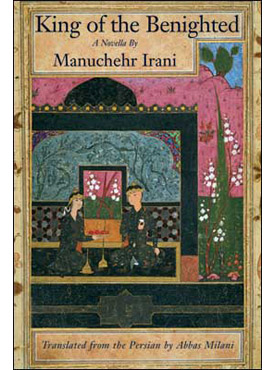About the Book
King of the Benighted was mailed out of Iran page by page. It is both a firsthand account of the hard realities of life under the Islamic Republic and a literary masterpeice by one of Iran’s best contemporary writers, Houshang Golshiri, who wrote under the pen name Manuchehr Golshiri to protect his identity. Golshiri has creatively combined modern techniques of fiction with the rich tradition of Persian poetry to tell a timeless tale. The novella invites the reader to join the flow of the artist’s imagination and to share moments in the life of a contemporary Iranian poet, including his imprisonment and incredible encounter with a young prisoner called Sarmad. Should you want to know why Iran has become a nation of mourners, you might follow the poet where he has gone.
King of the Benighted epitomizes a new emerging spirit in contemporary Persian literature and shows that despite Iran’s isolation today, its literature is very much part of the spirit sweeping the world. Included in this volume is an English prose rendition of the central metaphor of the novella, the 12th century poet Nizami’s “The Black Dome.” An insightful introduction by Nasrin Rahimieh and a perceptive afterword by the traslator reflect on the state of post-revolutionary Persian literature.
Note: This book was originally published in a numbered clothbound limited edition of 975 copies.
The German language edition is available from Amazon.de (Amazon.com’s German branch).
Reviews
“King of the Benighted is a book that transcends the limitations of time and space to explore the very essence of the human soul. . . . This book is a must for anyone interested in Persian literature.”
– -Small Press Magazine
“A thoroughly contemporary work, a lament for a lost utopia and an elliptical and bleakly horrific account of incarceration and torture in the Iran of the Mullahs.”
– – Times Literary Supplement
“An account of an intellectual experience with a political revolution and its consequences. Eminently readable and meaningful. . . . a revealing work, related in the terse and compact style characteristic of a superb and sophisticated modern writer.”
– – World Literature Today
“The restraint of the writing and the character of the poet, idealistic and unpolitical, make this a story to be read on many levels. It is a terrible indictment of a contemporary regime, but it is equally an allegory about the loss of innocence and hope.”
– – Kirkus Reviews
Like Simin Daneshvar’s Savushun, Manuchehr Irani’s novella King of the Benighted draws on medieval literature, in this case the Haft Paykar, or “Seven Portraits”, by the twelfthcentury Persian poet, Nizami. Irani’s title refers to the first of seven framed tales within the Haft Paykar, in which Prince Bahram visits the Princess of the Black Dome and hears from her lips a fairystory about a city, all of whose inhabitants wear the black of mourning, for each of them has individually visited a magical paradise, only to lose that paradise through greedy impatience. Playing intertextual games with this medieval allegory, King of the Benighted is a thoroughly contemporary work, a lament for a lost utopia and an elliptical and bleakly horrific account of incarceration and torture in the Iran of the Mullahs. Like Savushun, Irani’s fable recycles folklore for political purposes and the poet’s lengthy imprisonment turns out to be a modern version of the ancient motif of “years of experience in a moment of time”.
“Manuchehr Irani” is the shared name of writers publishing samizdat in Iran, or, as in this case, smuggling it out to the West for translation. King of the Benighted is a demanding work and, though it comes equipped with notes, an introduction and an afterword, the book’s editors do not seem entirely confident about the author’s meaning. In the introduction, Nasrin Rahimieh warns readers that those “seeking the definitive symbolic meaning of every utterance made by the anonymous narrator will have their expectations thwarted at every turn”. In the afterword, Abbas Milani denounces the contemporary “culture industry” in which “easy texts are legitimized at the expense of more formally demanding works”. Thus, a banned book in Iran, King of the Benighted may also be a book without legitimacy in the West.
– – Times Literary Supplement (March 1, 1991)
In the years that have followed the Iranian revolution of 197879 an intellectual debate has emerged about the notion of literary commitment as it had been constituted in prerevolutionary decades and about the relationship between literature and the sociopolitical reality which informs the consciousness behind the literary work. Whereas one group of writers and poets continues to propagate the idea of the literary text as an arena for the display of commitment to social justice as a goal achievable by political action, a more sophisticated group is producing texts that attempt to redefine the relationship in terms of the writing community’s experience with the Iranian revolution and its aftermath. King of the Benighted not only belongs to the second group of texts, but it actually thematizes the notion of commitment through literature. As Nasrin Rahimieh observes in her brief but pithy introduction, the protagonist, an Iranian poet, “is, in spite of the isolation he suffers, very much part of the new spirit sweeping the world.”
Unfortunately, we do not have the original Persian text. The translator Abbas Milani explains that the manuscript was sent to him incrementally, in envelopes containing a few pages at a time, until it was complete. The reason why the author, a famous Iranian writer using a shared pseudonym here, decided to smuggle his manuscript in the guise of letters is obvious: a bulky package is more likely to attract the attention of postal censors overseeing mail traffic into and out of the Islamic Republic. In his afterword Milani imaginatively turns this external fact into a metaphor for the story’s meaning: “Part of what the author wished to convey was already contained in the strategies of concealment and mutilation to which the manuscript had been, by necessity, subjected.”
Nevertheless, the English translation is expressive enough to give the reader a taste of the Iranian writer’s quest for a different, more culturally anchored sense of commitment through writing. On the surface the story depicts a middleaged poet’s brief arrest and incarceration, and his encounter in prison with a young militant guerrilla condemned to death for the murder of two Revolutionary Guards. Even though the young man has repented, possibly betraying many of his former comrades and testifying against them, in the end he is about to be executed by the revolutionary “brothers.” The poet is found to have done nothing threatening to the state and is set free after a brief interrogation.
This simple prison narrative is framed by and interspersed with the fable “The Black Dome” from the medieval Persian romancer Nezami’s Haft Paykar (The Seven Beauties). There we see a benevolent king bent on discovering for himself why the inhabitants of the “City of the Bedazzled” are all clad in black. Having subjected himself to an elaborate journey of discovery, he returns only to ask for black garments, which he wears “in mourning of the lost ideal; an ideal lost in callow hope.”
Thus the story becomes an allegory for the condition of a whole generation of Iranian intellectuals who have lost their ideal to a state that not only has not brought them closer to the fulfillment of their dreams but is threatening their survival as well. Under the weight of such disillusionment, the author seems to be saying, a deeper commitment beacons Iranian writers and poets to a new reading of their, literary heritage in a way that would make old texts relevant to modern times. The poetprotagonist contemplates the meaning of the medieval romancer’s parable: “That was the story…. What counts is the interpretation. It has to be an inner experience.”
King of the Benighted thus makes available to readers of English an account of an intellectual experience with a political revolution and its consequences. It does so through a sensitive translation, an inspiring introduction, and a perceptive afterword-all of which make the story eminently readable and meaningful. As usual, minor problems of popular translation and publishing interfere. The translator’s afterword, useful as it is, is too jargonridden and inflated in diction. Most of the footnotes are cumbersome, some inaccurate, a few even misleading. The note on the Tudeh Party (page 23) is simply too long and too loaded, and the allusion to a twentiethcentury poet named Farrokhi on page 74 is erroneously footnoted as relating to his eleventh century namesake. Transliterations and spellings of proper names are neither accurate nor consistent.
Such mistakes and oversights at times try the patience of readers, especially those concerned with scholarly standards of accuracy and consistency, but they detract not at all from the gripping power of the story itself. King of the Benighted is a revealing work, related in the terse and compact style characteristic of a superb and sophisticated modern writer. It has been brought home to speakers of English in an attractive little volume through the efforts of a publishing house that at present leads the field in translations of modern Persian literature. In addition to its interest for the general reader, the book is of central relevance to any college course focusing on contemporary Iran and the Middle East. It can also be an important part of any undergraduate survey course dealing with the literary treatment of a political experience or with the social status of intellectuals in the modern world.
– – World Literature Today (Spring 1991)
Everything about King of the Benighted, from the use of a pen name on a manuscript smuggled page by page out of Iran to the often elliptical and elegantly ephemeral prose, contributes to the beauty and mystery of this slender novella. It is not necessary to understand either the complex history of this part of the world or the state of contemporary Persian letters to fully appreciate this book; the central thesis of an artist in a repressive state, and in fact the meaning of art itself, is a universal one. It is to Manuchehr Irani’s credit that he has taken this theme and enlarged on it, examining the question from a variety of perspectives without ever losing sight of the basics of good storytelling.
An artist falls into a dream in which he imagines his future in the current police state; he considers what is important in his life, the tortures he will face, and the possibilities for personal expression. When he awakes, he reenters his life a changed man. This simple story is told in an intricate mixture of styles and voices, part allegory and part graphic history, in a narrative that is at times fragmented and diffuse and at other times painfully concise and straightforward. The writer weaves religious and secular metaphors, literary allusions and historical fact into a tapestry that encompasses not only the admittedly limited perspective of one man against a hostile world but also the intimidating complexity of society itself. ‘”That’s why he thought this lineage, if there is in fact a lineage, comes from the beginning of time, or from Besaribn Taharestani, the poet known as ‘The Chained,’; meaning the slave, whom Mahdi, the Abbassid Caliph, the Guide of the Pious, accused of heresy, and after having him flogged, ordered his body thrown into the swamps of Bataeh, to Ferdowski who was not buried in the Moslem cemetery, to him. and then to eternity…. And he sat waiting so that he too could get his share, or, pay his dues.” The poet is charged not only with his personal responsibility for the work but also for the historical and human context in which that work will be viewed.
King of the Benighted is a book that transcends the limitations of time and space to explore the very essence of the human soul. This alone would accord it the status of a contemporary masterpiece, but some mention should also be made of the exquisite production and the attention to detail which guarantee that this edition soon will become a collector’s item. This book is a must for anyone interested in Persian literature, and it would be a beautiful addition to any collection of modern fiction.
– -Small Press Magazine (October 1990)
Using an English-language translation of the Iranian poet Nizami’s story “The Black Dome” as a preface and a motif, the author depicts the experiences and thoughts of a poet in postrevolutionary Iran; in particular, his stay in prison and the people he met there. “Manuchehr Irani” is a generic pen name adopted by many writers living in Iran who publish outside the country.
– -Middle East Journal
This novella shows life for the creative artiste in postrevolutionary Iran as reminiscent of the reign of terror in the Soviet Union of Stalin and in George Orwell’s 1984. The influence of Franz Kafka (18831924) upon the novelist is also pronounced. The original manuscript was smuggled out of Iran bit by bit in several anonymous envelopes to the United States to evade the everwatchful censors, together with a plea by the anonymous author to have it translated into English and published under a suitable pseudonym.
Living amongst the horrors of a totalitarian policestate, the hero of this novella is brutally arrested by the secret police because of his refusal to make his poetry conform to the ideological propaganda of the state. His books are banned, his published poems destroyed. After horrific experiences in prison where he undergoes excruciating physical and mental torture along with his fellow inmates, he is suddenly and just as capriciously released to find his wife and daughter at home clad in black, having long given him up for dead. He looks in the mirror to find his hair has turned completely white.
The theme of this story is the author’s desperate plea for artistic, intellectual and religious freedom. This is accomplished, not by preaching, but by using symbolisms in the most eloquent and beautiful manner. Nothing is obvious there is only subtle suggestion. This very subtlety makes the emotional impact on the reader all the more gripping and powerful. This is a work which could only have been written by a highly skilled artist.
Tragically, however, the whole work from beginning to end is bitterly antiIslamic. Islam is equated with tyranny, despotism, intolerance and fanaticism, the greatest tragedy in the history of Iran being the Arab/Islamic conquest 1400 years ago. Every enemy of the Holy Prophet, of Islam and the Arabs of Persian history past and present is glorified as heroic. The novelist totally overlooks the immense cultural, artistic and spiritual enrichment Islam brought to Iran and Iran’s flowering under Islamic civilization without which its greatest classical poets like Firdausi, Jami, Sa’di Hafiz and Jalalud din Rumi could not have flourished.
The writer thoroughly confuses Islam with the acts of certain ignorant, corrupt and powerhungry Muslims today. In reality, what is described is not a true Islamic state but its monstrous perversion. The traditional Caliph or Sultan represented the opposite of vulgar modern dictators, demagogues and rabblerousers. Although it is quite true that individual personal liberty as the democratic West now understands it was not recognized under traditional Islamic civilization and social controls and restraints were severe, the dignity and nobility of the individual personality was always upheld. Many Muslims today (including thereviewer) fear that the triumph of another political order in the name of Islam and devoid of the purification of the heart, might, Allah forbid, be only another replica of what is described in the pages of this book.
– -Muslim World Book Review (Vol. 13, No. 4, 1993)
Smuggled out page by page, this novella by a highly regarded Iranian writer is being published in English under a pseudonym. Though the emotions are controlled, the language at times Iyrical, the story offers an insight into a society where totalitarian fanaticism intrudes into even the smallest and most private corners of life.
The story is preceded by a prologue that relates the old Persian tale of the Black Dome. all about a benighted king who mourns forever the loss of an ideal, “An ideal lost in callow hope.” The loss of ideals is the theme of the main story, in which a poet living in contemporary Iran had hoped for political change with the downfall of the Shah, but increasingly feels that Iran is now even worse off. He can get his poems published only abroad, and what he is writing seems irrelevant. But an arbitrary arrest, subsequent torture, and imprisonment further destroy his illusions. To pass the time, he recites verses to his fellow prisoners from the tale of the Benighted King. This recitation is responsible for his final and total disillusionment with the regime. Sarmad, a young fellowprisoner, is moved by the verses to confess to his role as a torturer and informer. A former activist, opposed to the Shah, Sarmad has been repeatedly forced by his captors to round up people from the streets who are then summarily shot each night in the corridors outside the cells. Even within the last few days, he has had to participate in the killing of his own wife. The poet is finally released, his hair now completely white, and his eyes fully opened to the horror of the present. He himself has become a “benighted king.”
The restraint of the writing and the character of the poet, idealistic and unpolitical, make this a story to be read on many levels. It is a terrible indictment of a contemporary regime, but it is equally an allegory about the loss of innocence and hope.
– -Kirkus Reviews (August 1, 1990)
Composed by a foremost contemporary Persian shortstory writer, King of the Benighted was recently sent page by page out of Iran. Manuchehr Irani is a pen name used by many writers living in Iran and publishing abroad. This author was imprisoned under both the Shah and Khomeini, experiences which inform this novella, written after the revolution. It is his first work to be initially published in English under a pseudonym. Translator Abbas Milani worked in Iran before, during, and after the revolution and currently chairs the Department of Social Science at the College of Notre Dame, Belmont. Milani’s afterword places the novella in cultural context. Also included as a prologue is a prose translation from the twelfthcentury Haft Peykar by the Persian poet Nizami of Ganja. This is a numbered, limited first edition from Mage Publishers. Other titles recently released by Mage include Maryam Mafi’s translation of Daneshvar’s Playhouse, short stories by Simin Daneshvar, Iran ‘s leading woman writer, and also Daneshvar’s bestselling novel, Savushun, translated by M.R. Ghanoonparvar.
– -Translation Review (#34 & #35 ,1990-91)
There is a conviction, often expressed, that Iranian life is best explicated with reference to classical Persian poetry. For many of us, contemporary Persian culture is more marked by its breaks with tradition than its continuities. At a time when massive additional breaks with classical culture are carried out, ironically, in the name of tradition, we may greet that conviction with skepticism, as the poet’s refuge into unreality, but King of the Benighted makes us believe it.
The subject, a poet in prison, can be a perilous one. The novelist’s dilemma is to find a point of view adequate to convey the experiences of horror without lapsing into another kind of writing, into a legal deposition or into sentimentality. It has happened before. Manuchehr Irani, rumored to be the penname of a wellknown Iranian novelist, frames the prison experience through the eyes of an eccentric poet who has been in similar prisons under the Shah, and the frame includes his comparisons. The particularity of the poet’s responses has a peculiar appeal and even a rueful humor, as in the painful moment when the police have arrived to take him away. His head covered by a sack, he becomes the limited, individualized point of view whose intellectual reactions are as important as the violence. “Suddenly a blow came down. It was not a fist…. Only with a book could they hit like that. But with which one? It didn’t matter . . .” (p. 41). It may not matter what book they hit him with, but he does bother to ask himself, and this makes all the difference.
The classical theme is an extended reference to the story of the city garbed in black from Nezami’s Haft paykar (told by the first of the storytelling wives, in the black pavilion), woven effortlessly and believably into the story. (The theme of blackness in that narrative generates the ingenious choice “benighted” of the English title.) A copy of Zaft paykar is sitting open on the hero’s desk when he is arrested, and he recites from it to fellow prisoners. Their reaction is surprising: “We’re young, we have many desires, we’ve never touched a girl’s hand in our lives; and then this guy won’t leave us alone with his erotic stories” (p.67). We learn later the personal connection his prisonmate sees between Nezami and his own horrifying moral compromises, doing the dirty work of the prison (handling the corpses of executed women). With that link the classical theme takes on a devastating psychological and moral depth. And in a mysteriously reassuring conclusion the poet’s copy of Haft paykar is still open to the same page when he returns from prison, to suggest a cultural still point, a vista of stability outside the protagonist’s pain and the horror of the last two regimes.
– – Middle Eastern Studies Assoc. Bulletin (#25, 1991)
Black may be beautiful. It may be a great colour. But it is the colour of doom. It signifies death, destruction, sadness, and mourning. It signifies loss, bereavement and compassion, an allpervasive despair, the absence of all hope. Imagine a country where the people are always required to wear black. What a depressing idea! And how unhappy the circumstances must be.
Such is the theme of Manuchehr Irani’s King of the Benighted translated by Abbas Milani. The origins of the book are interesting. Milani tells us in the Afterword that the book was mailed to him page by page out of Iran in the form of handwritten manuscript. This was perhaps the only way of escaping the country’s inexorable Islamic censors. Not surprisingly, the book is published under a pseudonym. A note tells us that Manuchehr Irani is a nom de plume used by many Iranian writers who publish their work abroad.
If this elaborate secrecy-smuggling the manuscript to a foreign country and then publishing it under an assumed name strikes us as strange and perhaps uncalled for, we merely have to remind ourselves of the narrow, Islamic bias of the Iranian regime. As an example, take the unnecessary hysteria it whipped up over Salman Rushdie’s venture into fantasy entitled The Satanic Verse. Little wonder, then, that writers from that country should feel the need to take refuge behind a pseudonym and get their books published elsewhere, in free-thinking lands where they would be accepted and appreciated, not criticized and hounded.
King of the Benighted would have been a seventypage novella were it not padded with an Introduction (which could have been dispensed with), a Prologue, and an Afterword. The Prologue is interesting as it gives us a translation of The Black Dome which is part of a longer poem entitled Haft Peykar (Seven Beauties) by the twelfth century Persian poet, Nizami of Ganja. The Black Dome contains a story within a story several times over in the manner of The Arabian Nights. Nizami’s story tells us of a king who suddenly disappeared from the midst of the people, like the mythical bird, Simurg. He wandered far and wide, to exotic, remote counties, suspended in a mysterious magic basket, or, Sindabad-fashion, clinging on to a gigantic bird. He reaches a paradise of sorts where a prolonged amorous encounter with a Fairy Queen ends in disappointment and he returns to reality, humbler but wiser clad in black. Black, thus becomes symbolic colour, symbolic of “an ideal lost in callow hope.”
This Prologue, which forms then matrix of the novella, initially raises false expectations as the reader is prepared for a children’s story, a fantasy narrative that would bring to life characters like Alibaba, Alladin, the genie, and all the others from the 1001 tales. This, however, does not happen. What follows, in King of the Benighted, is the experience of a man, a teacher, a poet, who, like Cinna the poet, is accused of writing “bad verses”. He is arrested time and again by a repressive regime that has little understanding or appreciation of the arts, but is convinced that all attempts at creativity must be viewed with suspicion. And so the unfortunate writer of the story is incarcerated, harassed, flogged and tortured. His fault? He is a creative writer. He is the author of The Demonic Decade which, to the powers that be, has seditious overtones.
The experiences of the writer at the hands of insensitive but powerful forces bring to mind those of Kafka’s Joseph K. We are also reminded of Orwell’s 1984 where the individual exists only for the state, all other concerns being irrelevant. King of the Benighted speaks of Islamic patrols that drive around in sinister Toyota station wagons through the cites of Iran, in search of spiritual or political deviants. It speaks of “Selection Centers” or “ideological commissars” that aim at purging all institutions of the regime’s political opponents. The narrative goes back and forth in time, presenting the consciousness of its anonymous protagonist who sees Nizami’s Black Dome as the central metaphor of the times. Living in an age farremoved from romantic, idealistic, utopian dreams, he sees the blackness of despair all around him. But underlying this grim vision is a stoicism that seems to advocate a holding on in the face of all despair.
What we have, thus, is a moving account of life in an Islamic republic which is not just a political document It is literary, too, in the sense that it evokes the rich tradition of Persian literature, with frequent references to Ferdowsi (we are perhaps more accustomed to the name spelt as Firdausi), Nima, and Hafez. And, yes, there is a liberal sprinkling of Nizami’s verses. All of this, and much more, in this elegantly bound and aesthetically presented slim, 100-page volume.
– -New Quest (March/April 1993)
Excerpt
Introduction to King of the Benighted
by Nasrin Rahimieh
At a time when the world has just celebrated the end of a decade marked with momentous change, it would seem inappropriate to speak of The Demonic Decade–the title the poet protagonist of King of the Benighted has bestowed upon a collection of his own poems. But his perspective is that of an Iranian who witnessed the brutal end of another era in 1979.
If we expect “The Demonic Decade” to set the tone of this novella, we are in for a surprise. King of the Benighted is not a litany of shattered ideals; it is a startling and at times ironic self-examination which never loses sight of the absurd and the humorous.
Led away to interrogation, the hero is grateful for small mercies: “So long as they hit with a book and on his head, then there is something to rejoice for.” Political commitment has given way to personal obsession. Will all of his books fit into the few boxes the interrogators have brought? Will they take away his precious copy of Nizami’s thirteenth-century poem? Will the cracked wing of the plaster angel, standing in his garden, survive the winter?
Those seeking the definitive symbolic meaning of every utterance made by the anonymous narrator will have their expectations thwarted at every turn. Like the thirteenth-century poem on which King of the Benighted is superimposed, this novella works on many levels. The poet’s remarks about Nizami’s The Black Dome are an apt description of the way in which his own novella should be read: “Well, that was the story. That is what he read. What counts is the interpretation. It has to be an inner experience, everyone must go through it.”
The “inner” journey upon which readers are required to embark is not unlike the one the king undertakes in The Black Dome. He sets out to learn why everyone is dressed in black in the City of the Bedazzled. He discovers the secret, only to emerge in mourning.
Should you want to know why Iran has become a nation of mourners, you might follow the poet where he has gone. Like the king in Nizami’s poem, you yourself may become ebonyclad. But, like the poet of King of the Benighted, while donning the obligatory black of the land, you might escape the worst and emerge with a head of white hair. In the end, you will be at once benighted and bedazzled.
All along the journey, illusions are shed and resolutions made. The wisdom at which the poet arrives while in prison is that he has indeed missed out on a decade. As he says to his cellmate: “I’ve been cheated. For about ten years, my only audience has been people like you. Now, I realize I haven’t written anything for a man in his forties, or even for myself.”
With this deaeration, the poet catapults his generation into a new literary era–one marked by an abrupt break with The Demonic Decade. He sees no point in writing about death, denouncing regimes, and spurring others to political action. For the anonymous hero of King of the Benighted, this is no time to lament, but a new chance at regeneration. This Iranian poet is, in spite of the isolation he suffers, very much part of the new spirit sweeping the world.
King also had to travel to China to find the City of the Bedazzled.
About the Author
Manuchehr Irani is a pen name used by many writers living in Iran and publishing their work abroad. The author is considered by his peers as the best contemporary Persian short story writer. Now that he has passed away it can be known that his name is Houshang Golshiri.
Fiction writer, critic, and editor, Houshang Golshiri was born in Isfahan in 1937. He was one of the first Iranian writers to use modern literary techniques, and is recognized as one of the most influential writers of Persian prose of the twentieth century. In 1965 Golshiri helped to found Iran’s chief literary journal, and in 1968 he established, along with other writers protesting government censorship, the Iranian Writers Association. Golshiri’s stories and efforts to establish basic rights for writers landed him in trouble– including imprisonment and a ban on his books–with both the Pahlavi regime and the Islamic Republic. In 1999 he was awarded the Erich-Maria Remarque Peace Prize for his struggle to promote democracy and human rights in Iran. Golshiri died, allegedly of meningitis, on June 5, 2000, in Tehran.
Mage has published a collection of his short stories, edited by Professor Heshmat Moayyad, called Black Parrot, Green Crow, as well as his novella, King of the Benighted first published by Mage in English under the psuedonymn Manuchehr Irani, translated by Abbas Milani. Houshang Golshiri’s stories “The Wolf” and “Portrait of an Innocent” in Stories from Iran: A Chicago Anthology.
Raised in Iran, Abbas Milani was sent to be educated in California in the 1960s. He became politically active and in 1974 received a PhD in Political Science. He returned to Tehran and taught at the National University but was imprisoned by the Pahlavi regime in 1977. After the revolution he became a professor at Tehran University, but in 1986 he emigrated to the United States. He is currently Chair of the Department of Social Sciences at the College of Notre Dame in Belmont, California and is a frequent contributor to the San Francisco Chronicle. He has also been interviewed for radio by the BBC and numerous NPR affiliates, and has lectured extensively. In addition, he has served on several editorial boards, published numerous articles and monographs, and has translated nine books from English into Persian. He has recently written his memoirs, Tales of Two Cities.
Nasrin Rahimieh is a professor at the University of Alberta. She has published a book on Middle Eastern writers in exile.








